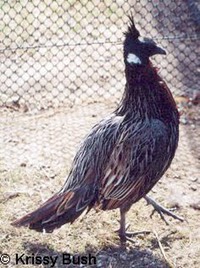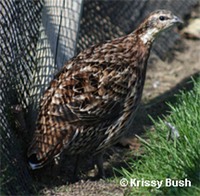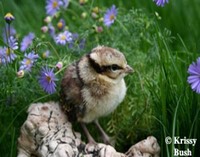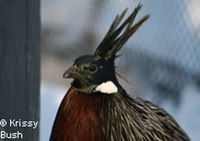Scientific Information
Class: Aves
Order: Galliformes
Family: Phasianidae
Subfamily: Phasianinae
Genus: Pucrasia
Species: macrolopha
Species English name: Koklass Pheasant
CITES Status: not listed
Distribution: Afghanistan to China
(from A Monograph of Pheasants Volumes I, II, III & IV, William Beebe)
***Not a true pheasant as determined by my genetic work published in 2003****
Description
• Male - Metallic green face, head, throat, & crest, white cheek patches, rust throat, chest, & belly, mostly grey back & wings with varying hues of brown and tan with dark "V" shaped barring, rusty-grey neck with same dark "V" barring, brown and cream tail, grey legs, and black beak
• Female - Creamish-brown body with dark markings, cream face, white cheek & throat patches, white tips on outside tail feathers, grey legs, & dark grey beak
Diet
• We feed our breeders and young adults 16% layer pellets, our tiny chicks 25% Turkey Starter crumble, and our growing chicks 20% crumble.
• They get a handful of mixed grains every second day except during breeding season, fresh greens (lettuce, chickweed, dandelions, grass) and fruits (tomato, grapes, berries, etc.) when available.
Breeding
• Done in pairs or trios.
• Koklass are first year birds. First year females may lay fewer and smaller eggs than older females.
• They start laying eggs around mid April and will lay every second day until they lay approximately 15 eggs.
• They lay a small to medium sized creamy-tan egg with brown spots egg.
Incubation
• Eggs are collected twice a day and marked with the date and breeding pen number and set daily.
• Eggs are set in an automatic turning Lyons Roll-X (RX2) with grid 89 or 109 depending on the size of egg.
• Temperature 99.8°F, humidity-wet bulb 82-84 with humidity adjusted periodically depending on development of the air space shown by candling
• On the final day of incubation, each egg is placed in its own oval wire mesh hatching basket (6" x 3" x 3") and set in the Sportsman Rattite hatcher.
• Incubation for Koklass is 25 days.
• After the chick hatches, it stays in the hatcher for a minimum of 8 hours.
Chicks
• Chicks look like small fuzzy versions of the female.
• They start out in our round 18" brooder pen with a mixed assortment of chicks. After a few days they are separated into a 2' x 4' baby pen for about a week. They are then transferred to a Koklass-Cheer-Impeyan 2' x 6' pen for the next 7-9 weeks. They stay with this grouping until they go outside. All of these brooding pens have wire bottoms with a heat lamp at one end and feed & water at the other end. The heat lamp is attached to a dimmer switch so we can turn down the amount of heat as the chicks get older until it is turned off completely.
• After they are off of the heat for a few weeks, they are moved outside to the pheasant house (has outside grassy pens and a heated inside house part where they are blocked in for the night). At this point they are separated into an all Koklass pen. After they are toughened up, they are moved to an outside chick pen.
• Koklass chicks are on the mean side and need to be kept with their own kind or large sturdy chicks like Cheer & Impeyan
Pens
• 25' long x 10' wide x 6' high with a 4' x 4' x 4' house in the middle.
• Pens are covered with 2" diamond top-rite.
• Pens contain grass, which does not need to be mowed since Koklass will mow the grass down like sheep.
• See Scintillating Copper Article for predator proofing set-up
Behavior
• Are calm and showy birds. The females are quiet and will walk around the pen eating grass and looking for bugs. The males love to display for any one that will watch them they flare their crest, beat their wings, and hop up and down. Koklass males have a unique crow during mating season that is quite loud. They are easy to tame down, but are not overly hardy (see below).
• Since Koklass are not a true Pheasant, they are more susceptible to disease like Grouse, Quail, and Partridge are. If you do not live where there is well drained soil, they need to be wormed frequently.
Article By Krissy & Donna Bush
Pheasant Ridge



